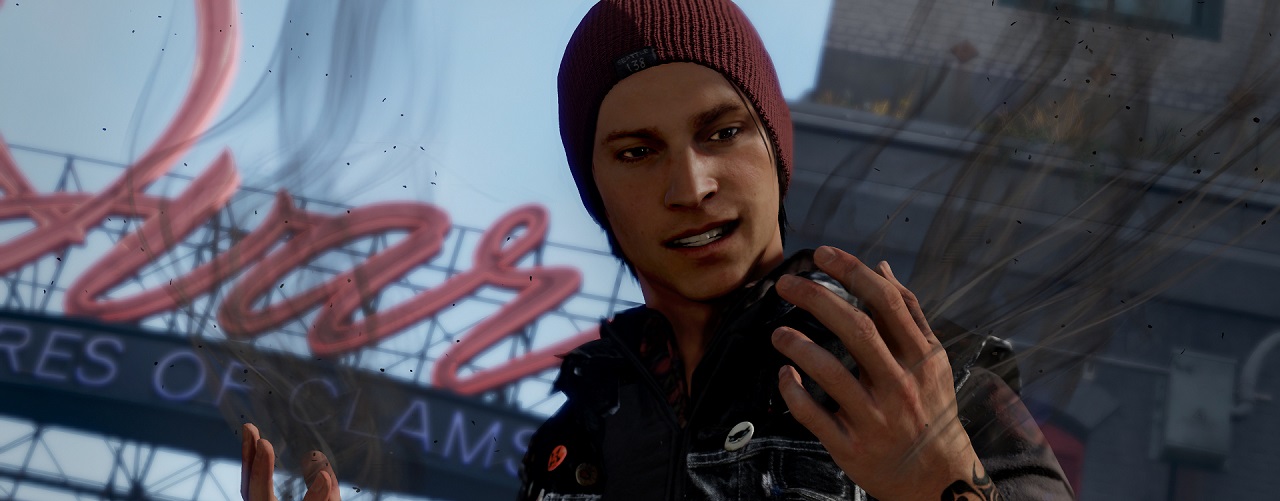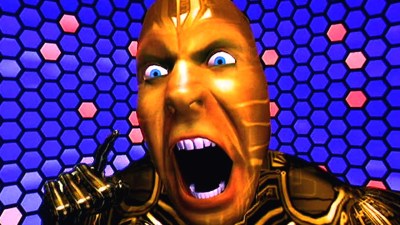Sony unveiled the PlayStation 4 in February 2013 at their press conference in New York, and InFamous: Second Son - initially expected to be a launch title - was among the first games shown for the system. Consumers watched the live internet stream with measured skepticism; a reflexive defense from repeated experiences of being burned by empty pre-launch promises. Simply put, it looked too good to be true.
After being delayed for four months Second Son turns up fashionably late into the launch window. The good news is that this time promises have been kept. The bad news is that Second Son isn’t substantial enough to escape the launch title brand. TL,DR: it’s small, yet compelling enough that you’ll happily engage everything Second Son’s depiction of Seattle has to offer, even if that means completing it twice.
Second Son is a new starting point for the series: the story revolves around delinquent graffiti artist Delsin Rowe (the titular Second Son) and his older brother Reggie, a police officer and the voice of authority who acts as a contrast to Delsin’s rebelliousness. Delsin, unbeknownst to himself, is a dormant “Conduit” - super-humans that are branded as bio-terrorists by the masses, hunted down and incarcerated by the fear-mongering Department of Unified Protection (DUP).
Delsin, already an outcast, is outed as a Conduit, putting his ethnic tribe - arguably the closest thing he has to an in-group - in danger. Delsin and Reggie set out to track down the head of the DUP and save their people. But for Delsin to be strong enough to take down the DUP he’ll have track down other Conduits to absorb their powers, as well as get to the DUP energy cores and Blast Shards marked on the map to unlock new skills - and this setup informs the majority of the gameplay.
This means storming DUP communications bases and blowing them to pieces with the power of smoke (and fire); it means imbuing movement with the electrifying power of neon; it means bounding a storey high and then running up the sheer face of skyscrapers, the city’s rooftops a series of platforms at your convenience.
Tying it all together is a binary morality system of red and blue. Through the few choices you get in the story, and which people you apprehend in the game (and whether it is done lethally or not), you’ll earn good or bad Karma. Get enough Karma and your ranking (hero or villain) will increase, granting you access to new skills that further enhance your ability to take enemies alive or simply take no prisoners.
Unfortunately, these choices all but make themselves. You’re locked into hero or villain mode early on in the game and can’t level the two extremes in tandem, unlike, for example, Mass Effect. Moral ambiguity is discouraged; there are no tangible benefits to being locked out of, or being under-ranked for certain skills – and narratively, playing in this manner causes Delsin’s motivations to flip-flop nonsensically between the two extremes of heady idealism and abject evil, breaking any sense of him being a believable character; not that his motivations entirely make sense to begin with, especially in the evil scenario, where you’re encouraged to attack not only aggravating anti-Conduit activists but also innocent street musicians and impartial civilians.
Delsin’s motivations for immediately identifying with the persecuted Conduits (after just receiving his powers) are also perplexing, at least initially. A life spent being the bad egg in the family and an outcast may have driven him to look for belonging wherever he could find it. And belonging is one of Second Son’s recurring themes; throughout the game many close to Delsin quip, “we take care of our own”. His blindsiding re-identification is rational - sensible, even - but difficult to buy into or empathize with; as with the morality system in the game, Delsin’s identification feels like a binary flick of a switch.
Binary would also describe the way NPCs respond to you. Even at the beginning of the game they transparently exclaim “I love you Delsin Rowe! You’re a hero!” (because you chose the hero option). At other times, they’ll hurl abuse at you: “You’re a bad man!” they’ll shout. “And your reactions are absurdly extreme!” you’ll shout back. NPC chatter might be the most omnipresent reminder of your ranking, but you’ll become apathetic to it after hearing so many NPCs distraughtly screaming “Why are you doing this!?” in response to you doing nothing in particular.
Regardless of moral alignment, the game plays the same - albeit with select missions (amounting to around 30 minutes of gameplay) being path specific. The ending, and character responses in the story, also change slightly - though the core story beats remain the same.
At its heart, this isn’t a story about good or evil. Second Son glosses over the comic-book convention of the origin story; Delsin’s acceptance of super-humanity happens almost nonchalantly. To quote Delsin from near the beginning of the game: “Right, of course the only downside [to having superpowers] being that, uh… nope, can’t think of anything. This is pretty freakin’ awesome!”
And he has a point, it is pretty freakin’ awesome. You’ll spend the 8 hours it takes to rush through the main game fighting the DUP - a paramilitary branch of the government whose ranks are filled with government-approved Conduits able to conjure concrete from thin air.
Having superhuman soldiers for foes encourages you to experiment, and that experimentation soon sees you using your environment in a way that lends a good degree of verticality to combat. If you can’t hit them through their concrete shields from the front, you can always comet punch them from a tall building. Likewise, if they can’t get a good angle on you because you’re too high, they can always rocket themselves into the air on concrete launch pads and give chase. Failing that, they’ll fashion concrete platforms onto the sides of buildings, creating impromptu sniper nests.
Developer Sucker Punch Productions was smart to create highly mobile enemies to keep up with a highly mobile protagonist. But the playing field is anything but even. It’s easy to anticipate enemy movements and focus charged explosives on their assumed trajectory. Health regeneration, although slow-acting, is easy to take advantage of as skirmishes already break down into hit-and-run encounters; running giving the player all the downtime they need to get back to health. Even on Expert difficulty you’re unlikely to die - short of accidentally walking into the middle of a very heavy fire zone.
Combat is easy but fun, in part because the aforementioned verticality allows you to use traversal skills (hovering and running along walls for example) in conjunction with offensive ones. But it’s also fun because it feels visceral [Editor’s Note - use that word one more time and you’re fired ;)]; cinders of projectile splatter weightily off enemy armor.
And you’ll be seeing a lot of combat. Every task on your map is either combat-oriented (taking down a drug gang, destroying a DUP checkpoint, attacking a communications center) or observation-oriented (locating the exact spot of a DUP camera or zeroing in on the precise location of a Blast Shard).
Most of these tasks establish their narrative justifications early on, so there’s no story or interesting character interaction as they happen. It’s a real shame, as the most entertaining of these quests is the District Showdown missions where Delsin
grieves and flirts with an understandably irate telephone operator to hilarious effect.
With no story or characterization, the optional content runs the risk of becoming routine. Second Son gets around this by only having enough content to keep the player busy just long enough before they get burnt out; the result is that Second Son feels slightly anemic and characteristically launch title-y. Even with the few mandatory communications raid missions padding the story out, this isn’t a long game.
To its credit, Second Son is infinitely more manageable than other open world games like Assassin’s Creed IV: Black Flag - which, although undoubtedly excellent, requires a lot of player investment before it opens itself up; this at least makes completing Second Son a relatively pain-free affair, viable without sinking in dozens of hours, but remaining enjoyable throughout.
This light serving of content is distinctive of launch (window) games, but Second Son’s graphics are very firmly rooted in this new console generation. These are not heavily tampered bullshots; the game really does look as impressive in motion as promised by official screenshots. Last generation-style city blocks of repeated textures are replaced here with unique details for almost every surface; shops all have their own signs and window advertisements, displayed with enough clarity that you can read opening times off tiny placards. It makes for an impressive display of what’s possible on the PlayStation 4 with the amount of graphics memory afforded to developers.
If anything, the high-bar visual presentation unduly highlights the few visual hiccups. Facial animations during cutscenes sometimes edge the line between disturbingly lifelike and uncanny-valley disturbing. And at times, the lighting’s adherence to realism is overly harsh -we could barely tell what we were looking at as digital pupils dilated - a minor, but common nuisance in a game where you can bound from enclosed, darkened areas to sun-kissed rooftops on a whim.
Sadly, the high-fidelity presentation doesn’t quite sell the story. The sharply written witty banter does a stand-up job of creating amusing character chemistry and injecting Delsin’s character with a boyish mischievousness - we were reminded of the easy banter from the Uncharted series - but emotional scenes don’t provide any sort of emotional punch. The game doesn’t make you sad or angry, it simply tells you that you’re supposed to be sad or angry.
InFamous: Second Son doesn’t feel like the whole package. The presentation is great, but how the game leverages that presentation leaves room for improvement. It takes place in a massive jungle-gym city for superhumans, but isn’t as packed with varied things to do as you might expect. And at the center of it all is a binary morality system that only just warrants a second playthrough. But with that said, you probably will play through it twice, and it’s a safe bet that you’ll spend the one or two play sessions needed in the post-game to get the 100% clear rating.
Second Son might not be a great game, but it’s a good game worth checking from corner to corner.


